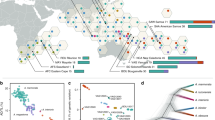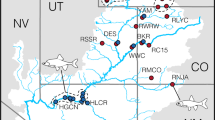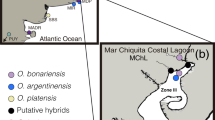Abstract
BOTANISTS have long recognized introgressive hybridization as important in the evolution of plants1, 2. Hybridization among animals is also common3, yet few zoologists have considered it evolutionarily important4–6. We report here that in the genus Gila, a morphologically diverse group of minnows from western North America7, we have discovered a pervasive influence of hybridization throughout their evolutionary histories. Gene exchange among distinctive forms has contributed to existing diversity, supporting the hypothesis that introgressive hybridization can play a significant role in evolution of vertebrates.
This is a preview of subscription content, access via your institution
Access options
Subscribe to this journal
Receive 51 print issues and online access
$199.00 per year
only $3.90 per issue
Buy this article
- Purchase on Springer Link
- Instant access to full article PDF
Prices may be subject to local taxes which are calculated during checkout
Similar content being viewed by others
References
Anderson, E. Introgressive Hybridization (Wiley, New York, 1941).
Grant, V. Plant Speciation 2nd edn (Columbia Univ. Press, New York, 1981).
Harrison, R. G. in Oxford Surveys in Evolutionary Biology Vol. 7 (eds Futuyma, D. & Antonovics, J.) 69–128 (Oxford University Press, New York, 1990).
Mayr, E. 1963. Animal Species and Evolution (Belknap, Harvard University Press, Cambridge, 1963).
Lewontin, R. C. & Birch, L. C. Evolution 20, 315–336 (1966).
Short, L. L. Ann. Mo. Bot. Gdn 59, 447–453 (1972).
Lee, D. S. et al. (eds) Atlas of North American Freshwater Fishes (NC State Mus. Nat. Hist., Raleigh, 1980).
Smith, G. R., Miller, R. R. & Sable, W. D. Proc. First Conf. Sci. Res. Nat. Parks 1, 613–623 (1979).
Rinne, J. N. Wasmann J. Biol. 34, 65–107 (1976).
Douglas, M. E., Minckley, W. L. & Tyus, H. M. Copeia 1989, 653–662 (1989).
Smith, G. R. Trans. Bonneville Chapter Am. Fish. Soc. 1983, 1–8 (1983).
Holden, P. B. & Stalnaker, C. B. Copeia 1970, 409–420 (1970).
DeMarais, B. D., Dowling, T. E., Douglas, M. E., Minckley, W. L. & Marsh, P. C. Proc. natn. Acad. Sci. U.S.A. 89, 2747–2752 (1992).
Hubbs, C. L. & Miller, R. R. Bull. Univ. Utah 38, Biol. Ser. 10, 17–144 (1948).
Wolfe, E. W. in Landscapes of Arizona (eds Smiley, T., Nations, J., Péwė, T. & Schafer, J) 111–136 (University Press America, New York, 1984).
Smith, G. R. Syst. Biol. 41, 41–57 (1992).
Sigler, W. F. & Miller, R. R. Fishes of Utah (UT St. Dept. Fish & Game, Salt Lake City, 1963).
Hubbs, C. L., Miller, R. R. & Hubbs, L. C. Mem Calif. Acad. Sci. 7, 1–259 (1974).
Miller, R. R. Copeia 1945, 104–110 (1945).
Minckley, W. L., Hendrickson, D. A. & Bond, C. E. in The Zoogeography of North American Freshwater Fishes (eds Hocutt, C. H. & Wiley, E. O.) 519–613 (Wiley, New York, 1986).
Neigel, J. E. & Avise, J. C. in Evolutionary Processes and Theory (eds Nevo, E. & Karlin, S.) 515–534 (Academic, New York, 1986).
Pamilo, P. & Nei, M. Molec. biol. Evol. 5, 568–583 (1988).
Dowling, T. E. & Brown, W. M. Syst. Zool. 38, 126–143 (1989).
Felsenstein, J. Evolution 39, 783–791 (1985).
Winograd, I. J. et al. Science 258, 255–260 (1992).
Axelrod, D. I. Calif. Acad. Sci. Occ. Pap. 132, 1–74 (1979).
Arnold, M. L. A. Rev. ecol. Syst. 23, 237–261 (1992).
Rieseberg, L. H. & Brunsfeld, S. in Plant Molecular Systematics (eds Soltis, D. E., Soltis, P. S. & Doyle, J. J.) 151–176 (Chapman and Hall, New York, 1992).
Shaklee, J. B., Allendorf, F. W., Morizot, D. C. & Whitt, G. S. Trans. Am. Fish. Soc. 119, 2–15 (1990).
Swofford, D. L. & Selander, R. B. J. Hered. 72, 281–283 (1981).
Nei, M. Genetics 89, 583–590 (1978).
Murphy, R. M., Sites, J. W. Jr, Buth, D. G. & Haufler, C. H. in Molecular Systematics (eds Hillis, D. M. & Moritz, C.) 45–126 (Sinauer, Sunderland, MA, 1990).
Swofford, D. & Berlocher, S. H. Syst. Zool. 36, 293–325 (1987).
Nei, M., Stephens, J. C. & Saitou, N. Molec. biol. Evol. 2, 66–85 (1985).
Nei, M. & Tajima, F. Genetics 105, 207–217 (1983).
Dowling, T. E., Moritz, C. & Palmer, J. D. in Molecular Systematics (eds Hillis, D. M. & Moritz, C.) 250–317 (Sinauer, Sunderland, MA, 1990).
Swofford, D. L. Phylogenetic Analysis Using Parsimony, version 3.0q (IL Nat. Hist. Surv., Champaign, 1990).
Author information
Authors and Affiliations
Rights and permissions
About this article
Cite this article
Dowling, T., DeMarais, B. Evolutionary significance of introgressive hybridization in cyprinid fishes. Nature 362, 444–446 (1993). https://doi.org/10.1038/362444a0
Received:
Accepted:
Issue Date:
DOI: https://doi.org/10.1038/362444a0
This article is cited by
-
An invariants-based method for efficient identification of hybrid species from large-scale genomic data
BMC Evolutionary Biology (2019)
-
Hybridization drives genetic erosion in sympatric desert fishes of western North America
Heredity (2019)
-
Isolation and characterization of 37 polymorphic microsatellite loci of Megalobrama hoffmanni by next-generation sequencing technology and cross-species amplification in related species
Journal of Genetics (2017)
-
Chromosome rearrangements, recombination suppression, and limited segregation distortion in hybrids between Yellowstone cutthroat trout (Oncorhynchus clarkii bouvieri) and rainbow trout (O. mykiss)
BMC Genomics (2013)
-
Hybrid fitness, adaptation and evolutionary diversification: lessons learned from Louisiana Irises
Heredity (2012)
Comments
By submitting a comment you agree to abide by our Terms and Community Guidelines. If you find something abusive or that does not comply with our terms or guidelines please flag it as inappropriate.



